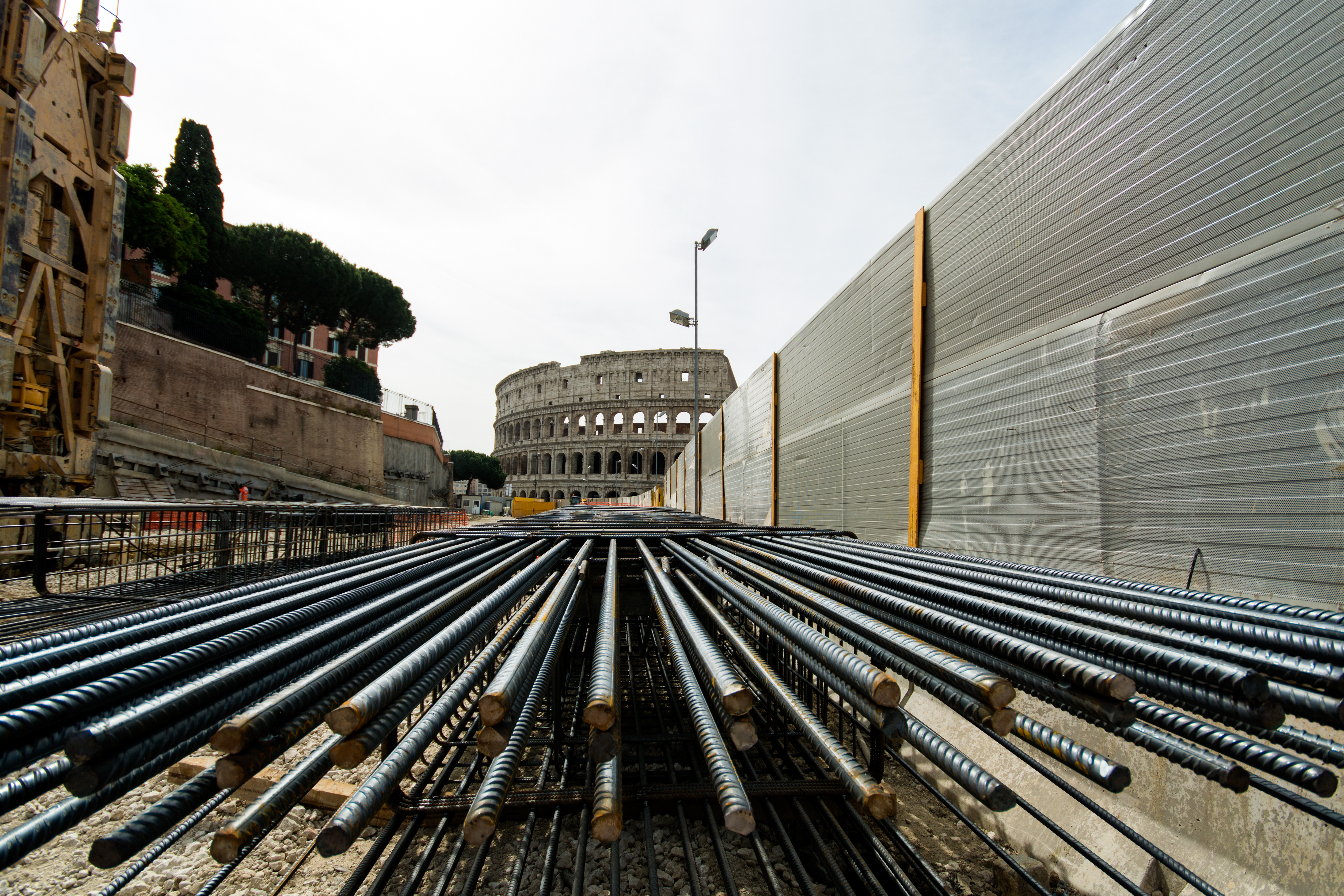
It is a long-held open secret of Rome that the city is traversed underground by a labyrinth of tunnels. The city’s tunnel network has been used for everything from catacombs to mushroom farming, and from bomb shelters to an unofficial sewer system. Protecting the historic legacy of this tunnel network is just one of the engineering challenges that the team behind Roma Metropolitane has to overcome in bringing the project to realisation.
Business Excellence recently had the pleasure of speaking with Mr. Andrea Sciotti, Technical Director of Roma Metropolitane, and Project Manager of Linea C, about some of those engineering challenges, as well as some of the hurdles unrelated to engineering that had to be overcome. During our interview, Mr. Sciotti exhibited something which appears common among teams on projects like Linea C forward: More than capability, they have a passion for the project that underpins their work.
Background: C is for Challenge
The C Line is the city of Rome’s third underground line, running from the eastern suburbs of the city through to its historic city centre. This route, leading into San Giovanni, is already in operation. Determining its route presented the first major challenge, as Mr. Sciotti tells us: “Italy has very strict conservation laws, so archaeology represented the first major challenge for us to overcome. Next, there were difficulties owing to the geological and hydro-geological context.”
Grasping the context that Mr. Sciotti refers to is crucial to understanding the specific nature of the Linc C project. He tells us: “The soil of Rome is characterized by fluvial-lacustrine recent sediments with extreme vertical and lateral lithological variations, and gradual or abrupt transitions.” In layman's terms, this means that Rome’s soil has huge inconsistencies, creating obvious headaches for engineers involved in the construction of a metro line.
And finally, the route of the C Line had to respect the city’s existing underground tunnel network, now including the first two lines of Rome’s metro system. Of this, Mr. Sciotti says: “The new lines must pass underneath the old ones; new artefacts have to be realized near the existing stations in case of interchange. This entails building deeper and deeper lines and programming partial realization steps for some of the station or tunnel artefacts.”
Extraordinary lengths were also taken to ensure the safety of the system. As Mr. Sciotti says: “Yes, we took an unprecedented action to design the best possible safety conditions with respect to fire risk through the experimental fire of a train car. The safety of passengers in the event of a fire on a train while in a tunnel is one of the most thoroughly explored issues in the design of the C Line. We were able to demonstrate in a proper manner, that the risk of propagation of a fire inside the line is practically non-existent and that the environmental conditions of the escape routes allow the safe evacuation of the passengers. The great technical, organisational and constructive effort and the cost involved in carrying out this experiment has allowed the testers to acquire irrefutable data to ensure the safety of passengers on the C Line of Rome’s metro system, but this important information was shared with the entire international scientific community,”
The Project in Numbers
When asked for the project’s vital statistics, Mr. Sciotti says: “The fundamental route represents one of the biggest ever undertaken in Europe. The C Line is 25.5 kilometres in length, has 30 stations, and a total of 5,500 parking spaces at those stations. The rolling stock is 30 trains - each composed of six cars. Each train measures 108 metres, with the maximum transport capacity for each train being 1,200 passengers.”
In terms of the engineering and construction required, Mr. Sciotti rolls off a number of the project’s statistics, having clearly become intimately familiar with each in intimate detail: “the construction requires excavations with archaeological assistance of 800,000 cbm and the use of 360,000 cbm of concrete and 270,000,000 kg of steel; the entire Fundamental Route will be equipped with 250 escalators, 87 electrical stations, 11 electrical substations, 200 ventilators, and 1,500 camcorders.” All of the trains also run on electricity and are driverless.
Needless to say, an operation of this scale is a significant investment. Mr. Sciotti says: “The estimated investment for T3, T4-T5, T6a, T7 sections of Line C (almost 22 km overall) and Graniti Depot, plus the preparatory activities of Section T2, is around 3.1 billion Euros – of which the largest share (over 63%) is borne by the State, and the rest is covered by Roma Capitale and Regione Lazio.”
A lasting contribution to the Eternal City
The C Line makes several notable contributions to a city where any new introduction to the landscape has a lot to live up to. First, there is the aspect of connectivity with the other lines. As Mr. Sciotti says: “The intersections planned with the two pre-existing lines (and the future D Line) of the Rome Metro system and with the Regional Railway “FL1” will considerably increase the “network effect” of the public transport system. This will shift a significant portion of trips from road to rail. In particular, the construction of the C Line meets the travel demand of the dense and populated eastern suburbs and is of great importance to tourist users visiting the historic center.”
There is also the aspect of integrating the system with its surroundings, most visibility in the metro’s new archaeological station. This allows passengers to view the works from the station itself, making it one of the most unique of its kind, anywhere. Mr. Sciotti tells us: “The thickness of the total archaeological layer in Rome can reach 20 metres. Mainly for this reason, the tunnels have to be placed almost everywhere at depths between 20 and 35 metres below the ground level, but the impact of the excavation of stations and intermediate shafts remains.”
He continues: “The structure of the route within the historic centre of Rome and the consequent need to vertically traverse the entire archaeological layer to link the underground, where the tunnels and platforms are located, with the surface where the accesses are present, have given to the C Line the connotation of “archaeological metro” – an infrastructure that is not only a means of transportation but also a means of knowledge and enhancement of the historical heritage of the city.”
He continues: “Among the most important discoveries made during the construction of the stations and the intermediate wells are: a vast farm at San Giovanni, active since the third century BC, to which was added in the first century AD the largest irrigation reservoir of ancient Rome ever found; a barracks of the first half of the second century AD, with the annexed “Domus of the Centurion”, at the Amba Aradam/Ipponio station; a building from the Trajan era (end of I-beginning of II A.D.) which has been unearthed near Largo dell'Amba Aradam, with the first ancient wooden ceiling ever found in Rome; a section of an aqueduct from the Republican era, perhaps the oldest of the Roman aqueducts, in Piazza Celimontana; the remains of the “Domus of the Prefect” at the Clivo di Acilio (Imperial Forums).”
Looking Forward
Line C has made huge progress, but more is to come. As Mr. Sciotti puts it: “The priority is the continuation of the line in the historic center, to make possible the pedestrianization of the most central and delicate area of the city. The tunnels have reached Piazza Venezia, at the edge of the perimeter of the future station whose design has been realized and for which in January Roma Capitale has asked the State for the necessary funding.” When the funding has been secured, Mr. Sciotti and his team will continue to do their part to ensure that the eternal city is eternally in motion.
DOWNLOAD
 MetroC-July2021.pdf
MetroC-July2021.pdf

















